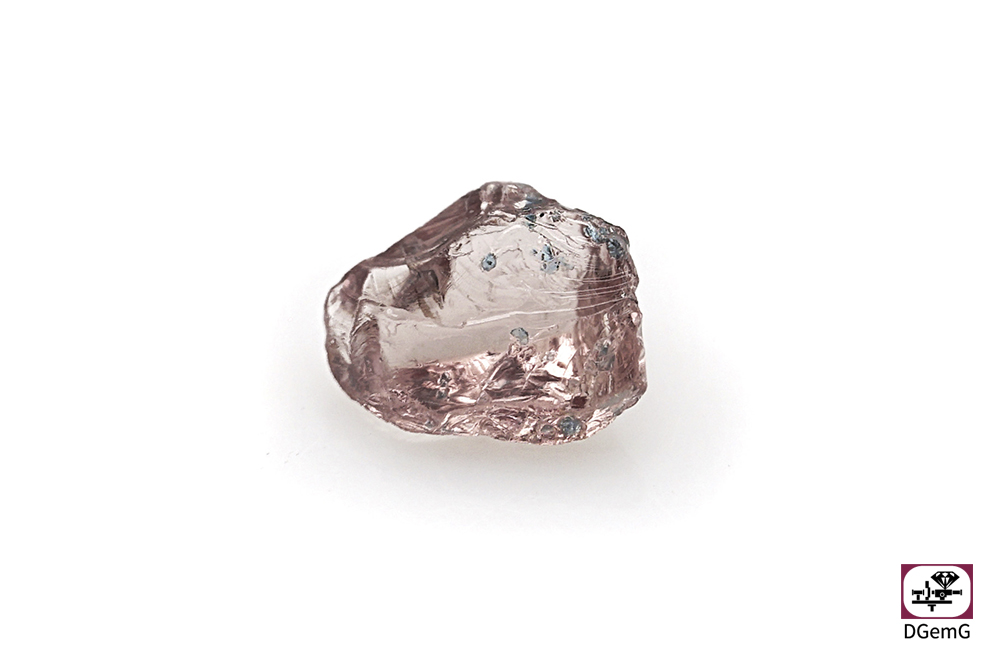Purple-pink coloured garnets with blue apatite inclusions have been on the market for some time and are becoming increasingly popular. The garnets come from a location in Tanzania. Hughes (2022) and Rizzo et al. (2022) have published articles in English.
Particularly on the internet, the stones are marketed as so-called “dragon garnets”. Due to their light pastel violet-pink colouring in daylight, they are classified as Malaya garnets in the trade, which is the term for garnets of a certain off-colour range. The trade name “Malaya” has been applied to garnets from the Umba Valley in Tanzania which have been on the gemstone market since the late 1970s/early 1980s. Their gemmological values of density and light refraction correspond approximately with rhodolite, but they can be clearly distinguished from rhodolite in terms of colour. These garnets show a mix of pastel orange-red-pink colours (see Lind, 2015).
According to mass spectrometric analyses (LA-ICP-MS) by Rizzo et al. (2022), the isomorphous composition of these garnets with apatite inclusions is determined to be 61.5 mol% pyrope, as well as spessartine (29.0 mol%), grossular (6.5 mol%) and almandine (2.6 mol%). This composition is typical for Malaya garnets.
 Fig. 2: A selection of microscopic images of the blue apatite inclusions (in immersion, x40-x80). Typical characteristics for apatite are idiomorphic, short to long prismatic crystals with a clearly hexagonal habit. In some cases, pronounced basal cleavage cracks can be observed. Photos: Q. Wang, DGemG.
Fig. 2: A selection of microscopic images of the blue apatite inclusions (in immersion, x40-x80). Typical characteristics for apatite are idiomorphic, short to long prismatic crystals with a clearly hexagonal habit. In some cases, pronounced basal cleavage cracks can be observed. Photos: Q. Wang, DGemG.
These garnets owe their distinct aesthetic and mineralogical characteristics to the blue mineral inclusions which are visible to the naked eye. The authors had the opportunity to examine eight rough stones as sample material from Lindi, Tanzania (Fig. 1). The density of the garnets is 3.80 g/cm3 with a refractive index of n = 1.742 which corresponds with the variation range for pyrope. Microscopically, the typical short to long prismatic structure of the idiomorphic, hexagonal apatite crystals is clearly recognisable, partly with visible cleavage cracks after the base. The inclusions were determined as apatite by S. Müller (DSEF German Gem Lab), as already by Hughes (2022) and Rizzo et al. (2022). The apatite crystals are commonly surrounded by rutile needles.
The garnets show a strong red fluorescence under long-wave UV light (365 nm) which is usually caused by chromium. This could be confirmed in the photoluminescence spectrum. Observation of the UV-Vis-NIR spectrum revealed the colour cause as a combination of manganese, iron, chromium and vanadium, which is also described by Rizzo et al. (2022).
As far as the naming of these garnets is concerned, different designations exist. “Dragon garnet” is to be understood as a trade name for Malaya garnets with blue apatite inclusions as a special feature. Garnets of the same colour but without apatite inclusions are usually called Malaya garnets but also named as champagne garnets in the trade. So far, there is no precise distinction of the naming described.
Literature
Hughes, E. B. (2022): Blue Apatite in Tanzanian Garnet.- Gems & Gemol. 58, 2, 226-227.
Lind, Th. (2015): Crystal chemistry and colour of garnets of commercially relevant gemstone occurrences.- Z. Dt. Gemmol. Ges. 64, 1/2, 1-41.
Rizzo, J., Renfro, N. & Sun, Z. (2022): Garnet with Apatite Inclusions.- Gems & Gemol. 58, 4, 491-492.
Authors
Christine Matter, FGG & Qi Wang, FGG, EG, both DGemG
© 2023



